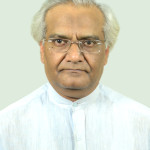ONCE UPON A TIME CHINA LOVED BHARATAVARSA !!!
Oh yes, they did, indeed !!
It was more than a millennium ago, Bharata exported Buddhism to China via Silk Route without even custom’s clearance !! And the cultural renaissance it brought about after Buddhism being lapped up so adoringly that it created a unique history of sorts. Two natural land routes into China for Buddhists during Han Empire (206 BC – 220 AD) were through Xinjiang i.e. Silk Route and the other through Yunnan, known as Chama Road.
In 68 AD, the then Han Emperor had a dream of a golden figure and he immediately deputed Cai Yin to Bharata to learn more about Buddhism. He returned with Buddhist scriptures and two Buddhist monks. Yuezhi now had a religion in which Buddha was a pantheon and Mahayana Buddhism started that way. Buddha in the form of large human statues like Greek deities, existed all over Central Asia, Xinjiang and China. Buddhism became popular and Buddhist temples were constructed in large numbers. Bingling Grottoes in Gansu is a sprawling ancient Buddhist temple complex with an array of statues and frescoes dating Ming Dynasty. Early statues have typical Bharatiya gestures and poses of hands and feet. Bezeklik Grottoes near Turpan depict Caucasian, Bharatiya and Mongoloid Buddhists together. Central Asians continued to propagate Buddhist teachings during Tang Dynasty (618-907) and it was popular and influential. Other big land route called Chama Road linked southeastern China with Tibet and through Tibet, Southeast Asia. Nanzhao Empire (738-902) was also influenced by religious teachings of Buddhists, constructed large Buddhist temples around capital Dali. These were thriving centers of Buddhism and propagated extensively. Three large Buddhist Pagoda-s famous as Three Pagoda-s still remain there raised during their rule.
Today China has largest number of Buddhist treasure, monasteries, temples and caves in the world, all facilitated via Silk Route alone though not a comfortable assignation indeed. Even today, the route has no facilities to brag about and it is an arduous venture to travel down the path as narrated earlier by Hiuen Tsang in his travelogue. Buddhist Masters were adamant in travelling to China carrying loads of books on Samskrita scriptures irrespective of the grave dangers of perishing due to starvation, thirst, being lost or even attacked by wild animals. They were always welcomed by Chinese monarchs warmly and the knowledge imparted by them received so adoringly. Their Vartalapa Pustika i.e. book of conversation invariably carried questions like, “Where are you from, how are you, what Samskrita scriptures have you brought with you and have you met the emperor” etc.
One of the most prominent cultural emissaries and Buddhist scholars was Kumarajiva who journeyed to China some 1600 years ago to whet their appetite for wisdom. Kumarajiva had a family history of erudition like his father Kumarayana, a Kashmiri Brahmana turned Buddhist monk who had also travelled to China along Silk Route to disseminate Buddhist wisdom. His mother Jiva was a princess of Kucha Kingdom that lay en route. He was born in 334 CE in Kucha Kingdom, now Kuqa in China and died in the year 413 CE in Chang’an, also in China. As a child prodigy, Kumarajiva studied Buddhist scriptures of Mahayana tradition and Veda-s inspired by his mother, by now a Buddhist nun. He was also fluent in Samskrita and Chinese. When he was instructed by his Guru to travel to China to disseminate the enormous wisdom gained, he was prevented by the King of Kucha as the King abhorred the idea of losing a scholar of his level of erudition !! That was a unique instance wherein brain-drain was prevented by the King !!
As Chinese invitations were not allowed to be accepted by him by his King, Chinese Monarch deputed an Army of 70,000 soldiers to capture Kumarajiva and escort him to China with great respect and honour. There he was honoured with the position of Royal Guru. Beautiful monasteries were constructed to enable him live there comfortably, teach and preach Buddhist philosophy to students from all over the Chinese Kingdom. He also supervised translation of Samskrita texts and scriptures into Chinese. Since Kumarajiva was a poet himself, he translated some 54 scriptures poetically, very unique way of translating scriptures including Lotus Sutra, Sukhvati Vyuha Sutra, Diamond Sutra, Amitabha Sutra, Mulamadhyamakakarika, Astasahasrika Prajnaparamita Sutra, Mahaprajnaparamita Upadesa, Pancavimsatisahasrika Prajnaparamita Sutra and Vimalakirtinirdesa Sutra being the prominent ones. His main disciples were Daosheng, Sengzhao, Daorong and Sengui. Kumarajiva revolutionized Chinese Buddhism through use of Daoist and Confucian terms i.e. concept-matching. His diction was distinctive gifted with smoothness that reflected his emphasis on conveying interpretation instead of precise literal renderings. Thus, seminal Mahayana texts have been more popular than precise translations.
His influence reached even Japanese shores that led to constitution of Soka Gakkai and Pureland sects of Buddhism. Japanese Prince Shotoku Taishi was so enamoured of Kumarajiva that he formulated Constitution of his Kingdom based on Buddhist wisdom like Bahujana Hitaya, Bahujana Sukhaya and Pancasila. Today Japan boasts of 65,000 Buddhist temples rooted in Kumarajiva’s teachings. So, quest for Sanatana / Buddhist wisdom was so pronounced in China that once they invaded Champa in Vietnam only to capture 1,300 Samskrita scriptures !! Great wall of China has ‘Supreme Victory’ inscribed in Samskrita even today.
The trend gradually reversed, turned vicious after Communist takeover of China in forties.
Ramakant Tiwari

